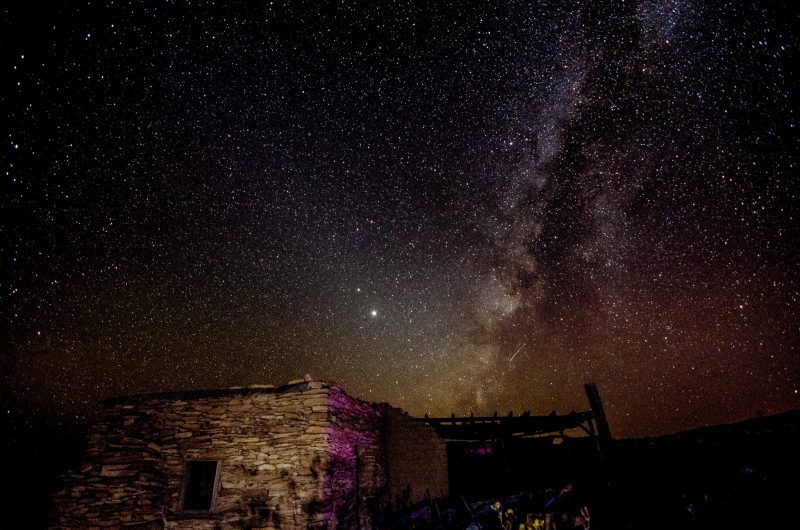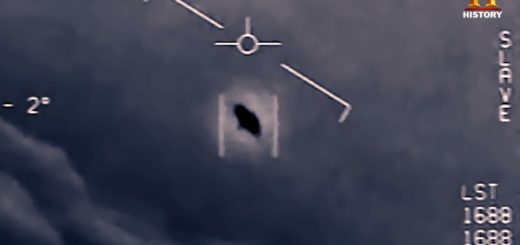What Is The Milky Way?

Do you think of the Milky Way as a starry band across a dark night sky? Or do you think of it as a great spiral galaxy in space? Both are correct. Both refer to our home galaxy, our local island in the vast ocean of the universe, composed of hundreds of billions of stars, one of which is our sun.
Long ago, it was possible for everybody in the world to see a dark, star-strewn sky when they looked heavenward at night, rather than the obscuring glow of city lights. In those ancient times, humans looked to the starry sky and saw a ghostly band of light arcing across the heavens, from horizon to horizon. This graceful arc of light moved across the sky with the seasons. The most casual sky-watchers could notice that parts of the band are obscured by darkness, which we now know to be vast clouds of dust.
EarthSky lunar calendars are back in stock! A few left. Get one while you can!
Myths and legends grew up in different cultures around this mysterious apparition in the heavens. Each culture explained this band of light in the sky according to its own beliefs. To the ancient Armenians, it was straw strewn across the sky by the god Vahagn. In eastern Asia, it was the Silvery River of Heaven. The Finns and Estonians saw it as the Pathway of the Birds. Meanwhile, because western culture had become dominated by the legends and myths of first the ancient Greeks and then the Romans, it was their interpretations which were passed down to a majority of languages. Both the Greeks and the Romans saw the starry band as a river of milk. The Greek myth said it was milk from the breast of the goddess Hera, divine wife of Zeus. The Romans saw the river of light as milk from their goddess Ops.
Thus it was bequeathed the name by which, today, we know that ghostly arc stretching across the sky: the Milky Way.
Edgewise view of the summer Milky Way in starry sky, on a dark night, between 2 rock cliffs.
View at EarthSky Community Photos. | William Mathe captured this image on August 15, 2020, and wrote: “Hiked up to the top of Rocky Mountain National Park in Colorado …just below 12,000 feet. Was greeted with a raging forest fire about 10 miles to the west … hung around long enough to get a couple of snaps of the Milky Way. You can see the brown clouds of smoke hanging in the valley below the rock outcrop on which I was perched.” Thank you, William.
When you are standing under a completely dark, starry sky, away from light pollution, the Milky Way appears like a cloud across the cosmos. But that cloud betrays no clue as to what it actually is. Until the invention of the telescope, no human could have known the nature of the Milky Way.
Just point even a small telescope anywhere along its length and you will be rewarded with a beautiful sight. What appears as a cloud to the unaided eye resolves into countless millions of stars, whose distance and close relative proximity to each other do not permit us to pick them out individually with just our eyes. In the same way, a raincloud looks solid in the sky but is made up of countless water droplets. The stars of the Milky Way merge together into a single band of light. But through a telescope, we see the Milky Way for what it truly is: a spiral arm of our galaxy.
Painting of circular face-on tight purple spiral with a yellow central bar.
We can’t get outside the Milky Way, so we have to rely on artist’s concepts, like this one, to show us how it might look. The larger orange/yellow blob in the lower part of the image is a massively glorified representation of our sun, showing its approximate location with respect to the center. Image via ESA.
Thus we arrive at the second answer to the question of what the Milky Way is. To astronomers, it is the name given to the entire galaxy we live in, not just the part of it we see in the sky above us as that river of light. If this seems confusing, we must acknowledge the need for our galaxy to have a name. Many other galaxies are designated by catalogue numbers rather than names, for example the New General Catalogue, first published in 1888, which merely assigns a sequential number to each. More recent catalog numbers contain information of far more use to astronomers, for example the galaxy’s location on the sky and during which survey it was discovered. Moreover, a galaxy may appear in more than one catalog and thus possess more than one designation. For example, the galaxy NGC 2470 is also known as 2MFGC 6271.
These galaxy designations are certainly unromantic, belying the dazzling beauty of the objects they are attached to. But other galaxies, particularly those brighter, closer galaxies which appear as more than just fuzzy smudges of light in a telescope, were given names by astronomers of the 17th and 18th centuries according to their appearance: the Pinwheel, the Sombrero, the Sunflower, the Cartwheel, the cigar and so forth. These names were attached to galaxies long before there were any systematic sky surveys that made it necessary to use numerical labeling systems, due to the sheer number of galaxies the surveys discovered. In time, the galaxies bearing these descriptive labels were incorporated into various catalogs, but many are still known by their names. Our own galaxy does not appear in any index of galaxies. There was, however, a need for a name to refer to it by. Thus we call it “The Milky Way” instead of “the galaxy” or “our galaxy”. So that name refers to both that river of light across the sky, which is part of our galaxy, and the galaxy as a whole. When not using the name, astronomers refer to it with a capital G (the Galaxy), and all other galaxies with a lowercase g.
Milky Way face-on, showing the central bar, major spiral arms, and the Orion Arm.
In this artist’s conception of the Milky Way, the sun’s location is shown below the central bar, at the inward side of the Orion Arm (called by its slightly dated name, the Orion Spur). The Orion Arm lies between the Sagittarius Arm and the Perseus Arm. Image via NASA/ JPL/ ESO/ R. Hurt/ Wikimedia Commons.
Our solar system is located about 2/3 of the way out from the Galactic Center toward the edge of the galaxy. We are, in fact, 26,000 light years from the center, or 153,000 trillion miles (246,000 trillion km). Under the stars we can look toward the middle of the galaxy or we can look in the other direction, out toward the edge. When we look to the edge, we see a spiral arm of the Milky Way known as the Orion-Cygnus Arm (or the Orion spur): a river of light across the sky that gave rise to so many ancient myths. The solar system is just on the inner edge of this spiral arm. If we look in the other direction, one would naturally expect to be able to see the center of the galaxy, which is located in the constellation of Sagittarius. But unfortunately, we cannot see it. The Galactic Center is hidden from us behind vast clouds of dark gas that telescopes operating in visible light cannot see through. It is only in recent decades that astronomers have been able to pierce that dusty fog with infrared telescopes to reveal what, throughout human history, has been concealed. With these new additions to astronomers’ arsenal of instruments, the study of around 100 stars at the galactic center revealed that those giant clouds of dark dust were hiding a monster: a black hole, designated Sagittarius A*, with a mass four million times the mass of our sun.
Colorful images of thick, irregular horizontal lines, stacked on top of each other.
The Milky Way as seen in different lights, that is, different wavelengths of light. The most familiar view is the one seen in optical light, which is the 3rd image from the bottom. Here, most of the galaxy is obscured by gas clouds (dark areas). But look in the same direction in infrared light, and you can see through the clouds (4th, 5th and 6th image from the bottom)! Read more about these images. Image via NASA.
Our Milky Way galaxy is one of billions in the universe. We do not know exactly how many galaxies exist: a modern estimate vastly increases previous counts to as many as 2 trillion. The Milky Way is approximately 100,000 light-years across, or 600,000 trillion miles (950,000 trillion km). We do not know its exact age, but we assume it came into being in the very early universe along with most other galaxies: within perhaps a billion years after the Big Bang. Estimates of how many stars live within the Milky Way vary quite considerably, but it seems to be somewhere between 100 billion and double that figure. Why is there so much variance? Simply because it is so difficult to count the number of stars in the galaxy from our vantage point here on Earth. Imagine being in a crowded room full of people and trying to count them without being able to move around the room. From where you are standing, all you can do is make an estimate because those people farther away from you are hidden by those closer. Neither can you even see what size and shape the room is; its walls are hidden from you by the mass of people. It’s exactly the same from our position in the galaxy.
It is this inability to see the structure of the Milky Way from our location inside it that meant for most of human history we did not even recognise that we live inside a galaxy in the first place. Indeed, we did not even realise what a galaxy is: a vast city of stars, separated from others by even vaster distances. Without telescopes, most of the other galaxies in the sky were invisible. The unaided eye can only see three of them: from the Northern Hemisphere we can see only the Andromeda galaxy, also known as M31, which lies some two million light-years from us and which is in fact the farthest object we can see with our eyes alone, under dark skies. The skies in the Southern Hemisphere have the Small and Large Magellanic Clouds, two amorphous dwarf galaxies orbiting our own. They are far larger and brighter in the sky than M31 simply because they are much closer.
Oblique view of a glowing spiral with fuzzy white patches out from it.
The Andromeda Galaxy (M31) is the closest large galaxy to our Milky Way. It’s seen here with two satellite galaxies: M32 is the compact fuzzy object located to the right of the Andromeda Galaxy’s center, and M110 is the more extended nebulous object at the top left of the central galaxy’s nucleus. Image via Zolt Levay/ Flickr.
Two irregular glowing fuzzy patches on the sky over several large telescope domes.
The Large and Small Magellanic Clouds over Paranal in Chile. These are satellite galaxies of the Milky Way and are only visible from the Southern Hemisphere. Image via the European Southern Observatory.
Until the 1910s, the existence of other galaxies had not been observationally confirmed. Those fuzzy patches of light astronomers saw through their telescopes were long believed to be nebulae, vast clouds of gas and dust close to us, and not other galaxies. But the concept of other galaxies was born earlier, in the early and mid-18th century, by Swedish philosopher and scientist Emanuel Swedenborg and English astronomer Thomas Wright, who apparently conceived the idea independently of each other. Building upon the work of Wright, German philosopher Immanuel Kant referred to galaxies as “island universes.” The first observational evidence came in 1912 by American astronomer Vesto Slipher, who found that the spectra of the “nebulae” he measured were redshifted and thus much further away than previously thought.
And then, Edwin Hubble, through years of painstaking work at the Mount Wilson Observatory in California, confirmed in the 1920s that we do not live in a unique location: our galaxy is just one of perhaps trillions. Hubble came to this realization by studying a type of star known as a Cepheid variable, which pulsates with a regular periodicity. The intrinsic brightness of a Cepheid variable is directly related to its pulsation period: by measuring how long it takes for the star to brighten, fade and brighten again you can calculate how bright it is, that is to say, how much light it emits. Consequently, by observing how bright it appears from the Earth you can calculate its distance, in the same way that seeing distant car headlights at night can tell you how far away the car is from how bright its lights appear to you. You can judge the distance of the car because you know all car headlights have about the same brightness.
Fuzzy cloud like blob with a bright light with lens spikes in the center.
An example of a Cepheid Variable star is RS Puppis. It varies in brightness by almost a factor of 5 every 40 days. Image via NASA/ ESA/ Wikimedia Commons.
One of Edwin Hubble’s great achievements was finding Cepheid variables in M31, the Andromeda galaxy. Hunched under the eyepiece of the huge Hooker Telescope in the cold night air, Hubble repeatedly photographed it, eventually finding what he was seeking in that distant spiral: stars which changed in brightness over a regular period. Performing the calculations, Hubble realised that M31 is not astronomically close to us at all. It is 2 million light years away. It is a galaxy like our own, long thought to be a third as big again as the Milky Way but which is now believed to be about the same size.
Hubble, for whom this discovery must have been a monumental shock, surmised that our galaxy was no different from M31 and the others he observed, thus relegating us to a position of lesser importance in the universe. This was as big a revelation and diminution of our position in the universe as when humans came to understand that the Earth is not the center of the universe: that we, along with the other planets we see, orbit the sun. We do not live in a special or privileged location. The universe does not have any vantage points which are superior to others. Wherever you are in the universe and you look up at the stars, you will see the same thing. Your constellations may be different, but no matter in which direction you look, you see galaxies rushing away from you in all directions as the universe expands, carrying the galaxies along with it. Until the work by Slipher and Hubble (and others), we did not know the universe was expanding and it took a surprisingly long time for this fact to be accepted by the astronomical community. Even Albert Einstein did not believe it, introducing an arbitrary correction into his Relativity calculations which would result in a static, non-expanding universe. However, Einstein later called this correction the greatest error in his career when he finally accepted that the universe is expanding.
Although Hubble showed us that ours is just one galaxy among perhaps trillions, this did not tell astronomers what the Milky Way would look like it if you were to see it from outside. We knew it has spiral arms: that band of light across the sky was clear evidence of that. But as to how many spiral arms there are, or how big the galaxy is, or how many stars inhabit it, those were questions still unanswered in the 1920s. It took most of the 20th century after Hubble’s discoveries to piece together the answers to these questions, through a combination of painstaking work with both Earth- and space-based telescopes. So if one could travel outside our galaxy, what would it look like? A standard analogy compares it to two fried eggs stuck together back-to-back. The yolk of the egg is known as the Galactic Bulge, a huge globe of stars at the center extending above and below the plane of the galaxy. The Milky Way is now thought to have four spiral arms winding out from its center like the arms of a Catherine wheel. But these arms do not actually meet at the center: a few years ago astronomers discovered that the Milky Way is in fact a barred spiral galaxy, having a “bar” of stars running across its center, from which the spiral arms extend at either end. Barred spiral galaxies are not uncommon in the universe, so our galaxy is certainly nothing out of the ordinary. We do not yet, however, understand how that central bar forms.
Horizontally stretched out glowing bulge – like a bar – with spiral arms around it.
This Hubble image shows galaxy NGC 7773, an example of a barred spiral galaxy thought to be similar to the Milky Way. Its bulge is stretched out into a bar-shaped structure, extending to the inner parts of the galaxy’s spiral arms. Astronomers believe a bar in the center of a galaxy is a sign of galaxy maturity. Younger spiral galaxies do not feature barred central structures as often as older spirals do. Image via ESA/Hubble, CC BY 4.0, Creative Commons.
Only two years ago, another major discovery was made: the Milky Way is not a flat disk of stars but has a “kink” running across it like an extended “S”. Something has warped the disk. At the moment the finger points at the gravitational influence of the astronomically-close Sagittarius dwarf galaxy, one of perhaps twenty small galaxies that orbit the Milky Way, like moths around a flame. As the Sagittarius galaxy slowly orbits around us, its gravity has pulled on our galaxy’s stars, eventually creating the warp.
These dwarf galaxies are not the only astronomical objects bound to our own. The Milky Way is surrounded by a halo of globular clusters, concentrations of stars looking like fuzzy golf balls, containing perhaps a million or so extremely ancient stars.
It is highly probable that we will continue to make more landmark discoveries about the Milky Way. The study of its nature and origin is accelerating as new astronomical tools become available, such as the European Space Agency’s orbiting Gaia telescope, which is making a three-dimensional map of our galaxy’s stars with exquisite and quite unprecedented accuracy: it aims to map a billion of them. Gaia’s data allows astronomers to see where the stars are, in which direction they are moving and how fast. This incredible map is already revealing previously-unknown features of our galaxy: the discovery of the galaxy’s warp by Gaia is one such feature. It is an extremely exciting time for the study of our galaxy, and the discoveries being made are telling us so much about not just our own galaxy but other spiral galaxies as well.
Star-strewn sky with Galactic band on the diagonal and a satellite telescope to the bottom right.
A composite image of the orbiting telescope Gaia, mapping the stars of the Milky Way. Image via ESA.
It is all a far cry from when, thousands of years ago, our ancestors ascribed fantastic beasts and gods to that mysterious band of light they saw as they stood in awe under the starry sky.
Bottom line: Our galaxy, the Milky Way, is a lot more than we can see from Earth without instruments. Here, we look into the origin of the name, the structure, and the fascinating history of how our knowledge of our own galaxy has developed over the centuries and continues to develop today.



 Creators of mankind
Creators of mankind Description of “Tall white aliens”
Description of “Tall white aliens” Where they came from?
Where they came from? About hostile civilizations
About hostile civilizations The war for the Earth
The war for the Earth “Tall white aliens” about eternal life
“Tall white aliens” about eternal life Video: “Nordic aliens”
Video: “Nordic aliens” Aliens
Aliens Alien encounters
Alien encounters The aliens base
The aliens base UFO
UFO Technology UFO
Technology UFO Underground civilization
Underground civilization Ancient alien artifacts
Ancient alien artifacts Military and UFO
Military and UFO Mysteries and hypotheses
Mysteries and hypotheses Scientific facts
Scientific facts


















